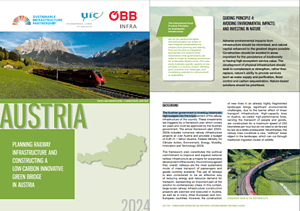SYMBIOSIS Interactive Session Highlights
The SYMBIOSIS interactive session was a highlight at the IENE conference where participants gathered to learn about the new ERJU funded project’s goals, as well as about the outputs of the previous BISON project. Engaging discussions on the future of rail transport, biodiversity monitoring, and the broader social and environmental impacts showcased a strong collective commitment to sustainable development among diverse stakeholders, all dedicated to making a positive impact on habitat management on transport and energy infrastructure development. The event focused on the following three different perspectives, concluding with a key message on best practices enabled by international collaboration.
1. Vision for the Future of Rail: Several key insights emerged regarding the future of rail transport (moderated by Andreas Seiler, SLU):
- Increased Capacity: A future was envisioned where rail efficiently accommodates both freight and passenger transport, enhancing overall service reliability.
- Enhanced Connectivity: The need for seamless and convenient connections across Europe and beyond were emphasised, including trans-border timetables.
- Improved Passenger Experience: A request was made to elevate rail services to compete effectively with medium and long-range road transport, providing an attractive alternative.
- Biodiversity and Climate Resilience: The importance of railway infrastructure serving as vital corridors and habitats, while contributing to climate adaptation efforts, was recognized.
- Social Value Creation: The potential for railways to enhance community well-being was discussed, with an emphasis on providing recreational corridors and affordable transportation options.
2. Prioritised Biodiversity Components for Monitoring: The session highlighted critical components for biodiversity monitoring, guiding SYMBIOSIS’s efforts in the transport and energy sectors (moderated by Thierry Goger, FEHRL):
- Land Take and Habitat Fragmentation: The need to reduce barriers and mitigate wildlife mortality risks was identified as essential for maintaining ecological integrity.
- Understanding the Ecological Rail Effect Zone: A requirement for further research to quantify the rail corridor’s impact and assess cumulative effects in relation to other transport infrastructures and land use was expressed.
- Integration of Habitats Related to Infrastructure: Acknowledgment of the need to recognise and incorporate impacted habitats into planning and monitoring processes was made.
- Management of Invasive Species: Strategies for mitigating the risks posed by invasive species to native biodiversity were deemed crucial.
- Verge Function Assessment: Evaluation of how verges can serve as both habitats and corridors, while being mindful of their potential as ecological traps and conduits for invasive species, was proposed.
- Focus on Pollinators and Invertebrates: The importance of preserving these vital species for ecosystem health was emphasized.
- Exploring Energy Production Opportunities: The investigation of renewable energy sources, such as biofuels, solar, and wind energy, along with carbon sequestration options, was suggested.
3. Societal Impacts Linked to Railways: Discussions revealed important societal impacts associated with railways (moderated by Lazaros Georgiadis, CERTH):
- Land Take for Compensation Measures: It was noted that compensation measures typically exceed the physical corridor occupied by rail, causing additional impacts on local communities.
- Rail facilities (tracks, stations, trains) could reclaim their once important role in society by providing good, reliable and attractive services. They could again become a transportation hub and social hub, but this has to be well designed (not just left for private entrepreneurs to fill the space).
- High-Speed Rail Barriers: The disturbances imposed by high-speed rail on wildlife populations highlighted the need for inclusive planning.
- Mobility Benefits of Medium and Short-Range Rail: The essential role of these services in enhancing local mobility and connectivity was recognized.
- Transforming Abandoned Railways: Advocacy for transforming unused railway lines into valuable recreational spaces like cycle paths was encouraged.
- Public Education Efforts: Raising awareness among stakeholders about the multifaceted benefits of rail systems was deemed important.
4. Addressing Challenges Ahead: Challenges that must be navigated collaboratively to realize the full potential of rail transport as a sustainable mode of transit were identified:
- Comprehensive Sustainability Assessments: A rigorous evaluation of impacts on society, environment, economy, and reversibility throughout all phases of development was called for.
- Connecting with the Energy Sector: Opportunities for utilizing rail corridors for energy production will be key in strategic planning.
- Shifting Focus Towards Public Services: An emphasis on enhancing local rail communication over merely competing with air travel was suggested.
- Advocating for Public Ownership: Ensuring that infrastructure remains primarily state-owned will help align commercial transport services with community needs and sustainability objectives.
- Educating Stakeholders on Sustainable Development: Transforming perspectives on degrowth and sustainability was identified as essential for fostering responsible practices.
- Developing a Long-Term Vision: A rethinking of the societal role of rail, prioritizing user needs and embedding infrastructure within local landscapes, was asked for.
Conclusion and Future Directions
Infrastructure plays a vital role in achieving the Sustainable Development Goals (SDGs), but conventional development harms the natural and social environment. Findings from UNOPS highlight that infrastructure relates to 92% of the 169 SDG targets, emphasizing the need for sustainable practices. The UNEP promoted principles guiding sustainability throughout the infrastructure lifecycle developed under the Sustainable Infrastructure Partnership (SIP) platform.
The session concluded with the announcement of the UNEP’s publication on sustainable railway infrastructure from ÖBB-Infra Austria, detailing the Austrian government’s €21.1 billion investment (2024-2029) to enhance sustainable transport, including the Koralmbahn project. This initiative features a new method for constructing bridges that reduces greenhouse gas emissions significantly. This method is tested in one of the green bridges or ecoducts that aim to reduce barrier effects on wildlife migration.
As the journey toward sustainable rail transport and biodiversity conservation progresses within the SYMBIOSIS project, heartfelt thanks are extended to all participants for their great contributions to this activity at IENE!
Stay tuned for more updates as SYMBIOSIS aims to lead sustainable infrastructure development and biodiversity initiatives that support multidisciplinary collaboration and create a harmonious balance between biodiversity, transport and energy sectors.


